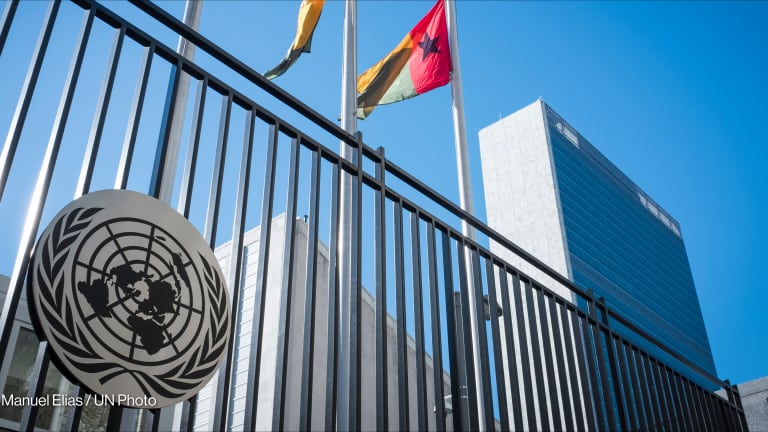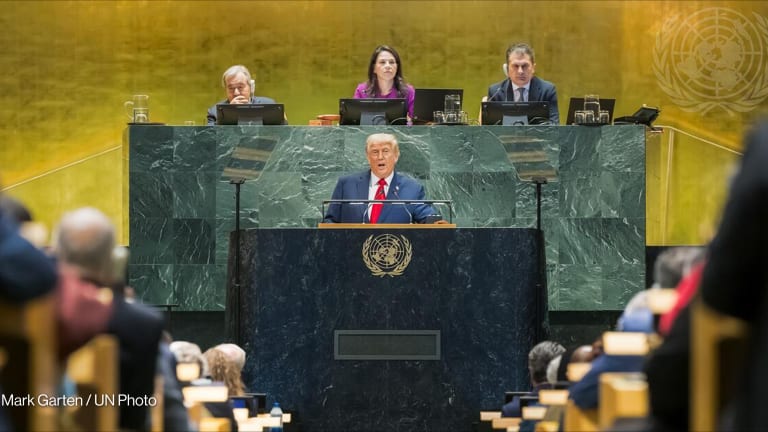
Love it or hate it — and, let’s face it, the man inspires a range of emotions — Donald Trump will take over as U.S. president in just a few weeks. And ever since his decisive election victory, everyone has been scrambling to read the tea leaves of what Trump 2.0 means for them. Development is no exception.
Fortunately we’ve been spilling the tea on everything we’ve learned so far — and it looks like it will be a bitter concoction for aid advocates to swallow.
Predicting exactly what Trump will do is like predicting what the exact temperature will be on this day next year. Good luck with that. But there are some common threads we’ve teased out on what a second Trump White House means for U.S. foreign aid, and in this special Saturday edition, we’re returning to some of our top-read stories of the year when it comes to the man who has upended U.S. politics — and, by extension, global geopolitics.
This is a preview of Newswire
Sign up to this newsletter for an inside look at the biggest stories in global development, in your inbox daily.
Over the next two Saturdays, we’ll also be exploring pertinent themes for 2025 based on our most popular stories of 2024, including European aid cuts and the future of international NGOs. For now, let’s dive into all things Trump.
Winners and losers
It appears the U.S. international affairs budget could be on the losing end of a Republican-dominated White House, Senate, and House of Representatives.
During his first administration, Trump proposed steep cuts to foreign assistance, but they were softened by the U.S. Congress. Any resistance, though, is likely to melt away as Trump assumes even firmer control of his party — and better understands the levers of government.
That could be very bad for USAID. In the past, Trump proposed cuts of up to a third of the agency’s budget, though the cuts were ultimately thwarted by dwindling pockets of bipartisanship in Congress. There’s no reason to suggest Trump won’t try again — putting even more money on the chopping block with less Republican opposition to stand in his way.
USAID is also likely to come under the microscope of DOGE, the so-called Department of Government Efficiency helmed by Elon Musk and Vivek Ramaswamy that aims to cut wasteful spending. But instead of cuts, could we see the wholesale elimination of U.S. foreign aid?
On social media platform X, formerly Twitter, Musk recently wrote “Ron is not wrong” in response to a post from former libertarian U.S. Rep. Ron Paul in support of banishing foreign aid altogether. “It’s taking money from the poor and middle class in the US and giving it to the rich in poor countries - with a cut to the facilitators in between! Americans don’t want their government to borrow more money to spend on foreign aid,” Paul wrote.
Not all Republicans are likely to go so far as to axe foreign aid altogether, but using taxpayer money wisely certainly isn’t viewed as a radical proposition.
“What the right wants is good governance and effective use of money to counter our enemies abroad, and anything else that goes on, we’re going to oppose,” Max Primorac, who served as a senior adviser at USAID during the first Trump administration, told my colleague Michael Igoe in June.
Multilateralist casualties: International institutions also won’t be immune to Trump’s “America First” governing ethos. The United Nations, a perennial bugbear of Republicans, could see its funding slashed or outright eliminated — we’re looking at you, U.N. Population Fund.
But the U.N. may not be caught off guard by the cuts. Richard Gowan of the International Crisis Group told my colleague Colum Lynch last month that he believes U.N. Secretary-General António Guterres and his team “are as prepared as they can be for what they expect to be a financial firestorm as Trump comes back. There are plans to try to piece together funds from other countries to keep the organization afloat through the next year at least.”
Other multilateral institutions that may be looking to other countries to help tide them over? The World Bank and International Monetary Fund. While Trump approved a capital increase for the World Bank the last go-around, the infamous Project 2025 conservative playbook (we’ll get to that later) has proposed going so far as to withdraw from the World Bank and IMF entirely.
Whether that comes to pass remains to be seen, but U.S. pledges are certainly in doubt. In the recent replenishment of the bank’s International Development Association, or IDA, there’s a reason President Joe Biden’s contribution of $4 billion didn’t make waves — because it could easily be axed by his successor.
The beneficiaries: All the talk about cuts belies the fact that some organizations could see a boost. The U.S. International Development Finance Corporation, or DFC, is celebrating its fifth anniversary this month — and the supersonic growth it’s enjoyed over those five years. The agency was born during the last Trump administration and its focus on private sector investment and acting as a counterweight to China all seem to align perfectly with Republican priorities.
Another likely winner? Faith-based organizations, particularly the evangelical community, whose supporters received key posts in the State Department, the Department of Health and Human Services, and USAID during Trump’s first term. “Former missionaries, veterans, members of diasporas, and faith community stakeholders with overseas experience should be recruited to work at USAID,” Primorac wrote in Project 2025.
Primorac also pointed out that localization could be a rare area of convergence among Democrats and Republicans, with both backing efforts to shift more U.S. funding to local organizations instead of the same set of major global aid contractors.
Asked what he sees as the largest impediment to localization, Primorac told Devex back in June: “It’s an easy question. It’s the aid industrial complex lobbying Congress.”
Go deeper:
• Donald Trump won. What does that mean for development?
• The Republican plan to ‘rightsize’ US foreign aid in a Trump presidency (Pro)
• What we do and don't know about Trump's US aid plans (Pro)
+ A Devex Pro membership helps sustain the journalism we’re able to bring you. Not yet gone Pro? Start your 15-day free trial today to access all our expert analyses, insider insights, funding data, exclusive events and career resources, and more. Check out all the exclusive content available to you.
Culture wars crosshairs
It’s too soon to tell which policies and programs will be elevated, nixed, or emerge relatively unscathed under a Trump White House, but you can safely say goodbye to those promoting climate change; reproductive rights; and diversity, equity and inclusion, or DEI.
In 2016, Trump promptly pulled the U.S. out of the Paris climate agreement. There’s no reason to expect he won’t do so again given that he’s repeatedly called climate change a hoax and fiercely supports the use of fossil fuels.
Upon taking office, he’s also likely to swiftly reenact the Mexico City Policy, also known as the global gag rule, which prohibits U.S. family planning funding to organizations that provide abortion services or information. It’s a bipartisan rite of passage to either rescind or reenact the rule — Democrats waste no time getting rid of it when they come to power — but in his first term, Trump expanded the policy to apply to all U.S. global health funding and many expect that he could apply it to all U.S. foreign assistance this time.
Beyond reproductive rights, global health traditionalists could be in for a rude awakening if Robert F. Kennedy Jr. is confirmed to lead the Department of Health and Human Services.
Among other questionable theories, RFK Jr. has linked vaccines to autism, called the COVID-19 vaccines deadly, and cast doubts on the long-established fact that HIV causes AIDS, touting false claims by AIDS denialists.
“I think that we’re likely to see a wholesale pullback and restructuring of America’s global health presence around the world, and that will affect … United States diplomacy, particularly on the pandemic agreement, its relationship with the World Health Organization and other U.N. agencies, and then funding and partnerships,” Lawrence Gostin, the O’Neill Institute chair in global health law at Georgetown University, told my colleague Jenny Lei Ravelo earlier this month.
Read more:
• Inside the global anti-abortion coalition preparing for Trump’s return
• Will RFK Jr. ‘go wild’ on global health?
Personnel is policy
RFK Jr. is hardly the only controversial pick out there, but some are more establishment-type and expected — such as Marco Rubio for secretary of state. For the development sector, the million-dollar question is: Who will lead USAID?
Sorry, we don’t know — yet — but we have intel on who you should be keeping an eye on. Here are a few examples of who our Senior Reporter Michael Igoe says could shape foreign aid in Trumpworld:
• Bill Steiger.
USAID chief of staff under Mark Green, former chief program officer at Pink Ribbon Red Ribbon, and godson of former President George H. W. Bush. Known as a behind-the-scenes operator with an unrivaled grasp of U.S. foreign assistance regulations, Steiger is a strong advocate for changing how USAID spends its money.
• Jim Richardson.
Former director of the State Department's Office of U.S. Foreign Assistance Resources, coordinator of USAID's Transformation Task Team, and close aide to Mike Pompeo. Known for leading the largest-ever restructuring of USAID, advocating for better coordination of U.S. aid agencies, and telling U.S. development partner countries that if they work with China, “it is bad.”
• Max Primorac.
Project 2025 lead author, former USAID senior official, envoy of former Vice President Mike Pence. Known for accusing Democrats of using aid for “social re-engineering” and arguing that aid budgets are too big.
Project 2025, co-authored by Primorac, is the conservative doorstop that spells out a detailed policy agenda for a second Trump administration.
After Democrats used Project 2025 as an albatross around Trump’s neck during the election campaign, the then-candidate disavowed the document. But it was written by dozens of his former staff members, so it’s entirely plausible the president-elect will pivot and bring some familiar faces back into the fold.
Read more:
• Return to Trumpworld — who will shape US aid policy? (Pro)
• ‘We can work with him’ — aid advocates react to Trump’s Rubio pick
+ Check out our page dedicated to the future of U.S. aid.
Sign up to Newswire for an inside look at the biggest stories in global development.








